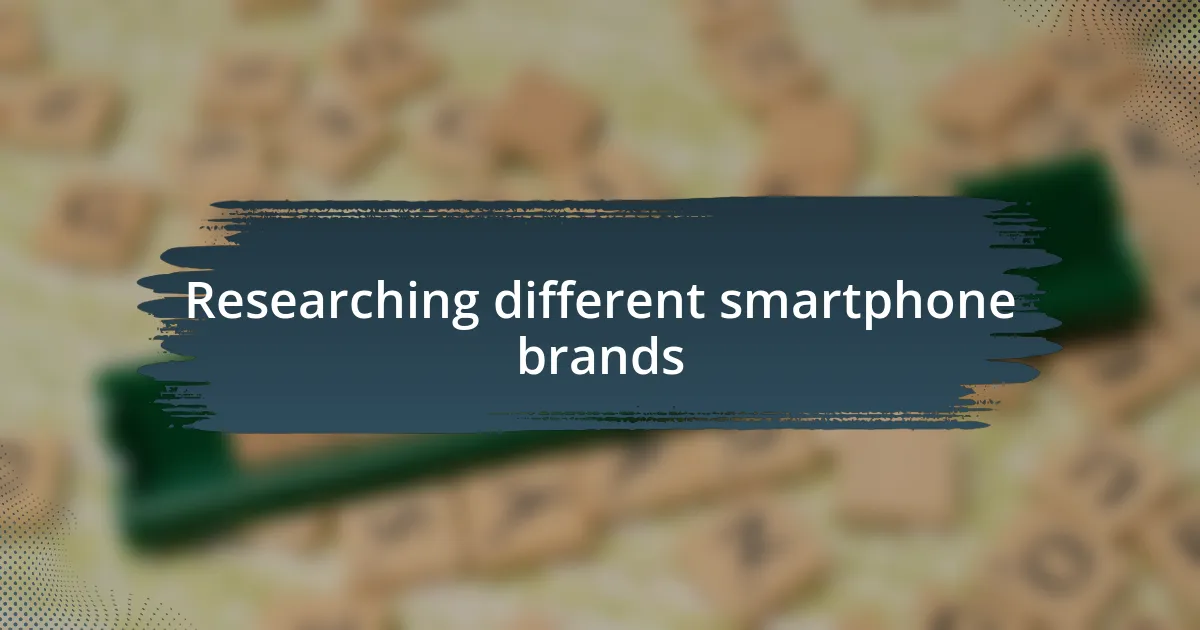Key takeaways:
- Identifying personal smartphone needs, such as prioritizing battery life and reliable app performance, guided a focused selection process.
- Comparing key features like processing speed, operating systems, and storage helped tailor choices to individual usage habits and preferences.
- Researching different brands and evaluating user reviews revealed valuable insights into durability and post-purchase support, influencing brand selection.
- Understanding operating system preferences impacted overall user experience and productivity, ultimately leading to a more satisfying smartphone choice.

Identifying my smartphone needs
Identifying my smartphone needs was more than just ticking boxes; it required me to reflect on how I use my device daily. I realized I rarely took photos, so a high-end camera wasn’t essential, which saved me from splurging on unnecessary features. Have you ever felt overwhelmed by all the options available?
As I mapped out my daily routine, I noticed that battery life held paramount importance for me. Long commutes and a hectic schedule meant I needed a phone that could easily last all day without searching for a charger. It was a game changer to finally pinpoint what truly mattered.
Additionally, I considered how often I used apps versus making calls. Since I enjoyed streaming music and podcasts, I prioritizing a device with a good display and sound quality. Isn’t it fascinating how our needs can vary so greatly? This realization helped me tailor my search and saved me from the common pitfall of buying a phone based on mere trends.

Comparing key smartphone features
When it came to comparing key smartphone features, I found myself focusing on the essentials that mattered most to my lifestyle. For instance, while some may prioritize camera quality for stunning vacation shots, I leaned more toward processing speed. There’s nothing more frustrating than a laggy phone during a morning rush; I remember missing an important call once because my device took too long to respond. Have you ever been there? It makes the comparison between features feel incredibly real.
Another critical factor was the operating system. I’ve always gravitated toward user-friendly interfaces, and I recall transitioning from one system to another—what a headache that was! I prefer iOS for its seamless integration with other Apple devices, but I also appreciate the customization options Android offers. It’s all about finding that right balance that caters to your preferences.
Battery life and storage were equally important. I’ve been in situations where I was out all day, and my phone drained faster than I anticipated. A reliable device that could handle my streaming habits without compromising performance felt like a must. In terms of storage, I learned the hard way that running out of space on a weekend trip can spiral into chaos!
| Feature | What to Consider |
|---|---|
| Camera | Essential for photography enthusiasts versus adequate for casual users |
| Processing Speed | Important for multitasking and app performance |
| Operating System | User interface preference and ecosystem compatibility |
| Battery Life | Longevity for heavy users during busy days |
| Storage | Capacity needed for apps, media, and documents |

Researching different smartphone brands
Exploring different smartphone brands was an eye-opener for me. Each brand brings its unique flavor, whether it’s the reliable reputation of Apple or the innovative edge of Samsung. I remember diving into user reviews on forums and tech sites, fascinated by the varying experiences people had. It was like peeking into others’ lives, and it often highlighted features I hadn’t even considered before.
When I turned my focus to specific brands, I made a mental note of the following points:
- Reputation: Esteemed brands often have a history of customer satisfaction and reliability.
- User Reviews: Real-life experiences can reveal strengths and weaknesses that specs might not show.
- Product Ecosystem: Brands like Apple excel in creating a seamless experience across devices.
- Price vs. Value: Sometimes, a mid-range brand offers fantastic quality at a fraction of the price.
- Post-Purchase Support: Companies that provide excellent customer service make the experience much more enjoyable.
As I sifted through this information, it dawned on me how valuable it is to truly understand what each brand stands for. I recall my own surprise when I found out about a little-known brand offering fantastic durability for a great price. Research saved me from a potential buyer’s remorse!

Evaluating smartphone performance reviews
Evaluating smartphone performance reviews can be a bit of a rabbit hole, but it’s essential for making an informed choice. I remember reading a review about a phone claiming “unmatched speed,” only to discover later that the reviewer had a very different usage style than mine. This realization forced me to dig deeper, asking myself: What does “performance” really mean in the context of my everyday use?
When sifting through reviews, I focused on aspects like processor speed and RAM, certainly important, but I also sought out real-world performance tests. I’d watch videos where tech reviewers ran multiple apps simultaneously. Seeing how a phone handled gaming or video streaming gave me insights that specs alone couldn’t provide. Isn’t it fascinating how a phone can sound impressive on paper but falter in real life?
Lastly, I often encountered conflicting opinions, which made me pause. One reviewer loved the camera quality, while another slammed it for low-light performance. I learned to weigh these perspectives, aligning them with what mattered most to me. After all, I needed a device that would excel not just in reviewers’ labs, but in my daily adventures.

Analyzing battery life and durability
When considering battery life, I learned that it’s not just about numbers; it’s about how I actually use my phone. Some claims sounded amazing, but after a few hours of heavy use, I’d find myself scrambling for a charger. I cherish those moments when my phone lasts throughout a busy day filled with meetings and social media, as they offer a sense of reliability that is truly comforting.
Durability became a key focus for me as well. I vividly remember dropping my previous phone and watching helplessly as the screen shattered. That incident taught me the importance of ruggedness in a device. While brands might tout high IP ratings for water and dust resistance, I wanted something that could withstand the everyday wear and tear of my lifestyle—especially during outdoor adventures or unexpected spills.
How do you really measure a smartphone’s battery life and durability? For me, it came down to real-world experiences rather than specs alone. After learning from user reviews and personal encounters, I found devices that offer solid battery performance and rugged features can give me the confidence I need—not just in daily tasks, but in knowing my phone can keep up with my life.

Understanding operating system preferences
Understanding operating system preferences
Choosing the right operating system (OS) for my smartphone was a pivotal step in my decision-making process. I still recall the moment I switched from Android to iOS. Initially, I was enticed by the vast customization options that Android offered. However, after a few weeks, I found myself craving the seamless integration and user-friendly nature of iOS that made daily tasks feel effortless.
This preference for a specific OS often reflects how I engage with technology. I noticed that I heavily rely on certain apps that function better in one environment over another, leading me to consider compatibility as a major factor. Have you ever felt frustrated when an app just doesn’t run as smoothly on your current OS? That was my experience with Android when trying to use a photo-editing app that worked flawlessly on my friend’s iPhone.
In the end, my choice came down to how each OS aligned with my lifestyle. The fluidity of iOS made it easier for me to stay organized, as I juggle work and personal projects. When I saw the way my phone interacted with other devices in the Apple ecosystem, I felt a sense of relief knowing that those tools would enhance my productivity rather than complicate it. Ultimately, my operating system preference became a reflection of my values—efficiency, simplicity, and connectivity.











